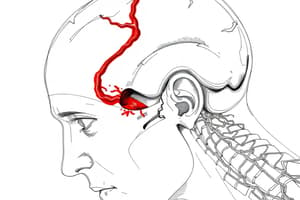Podcast
Questions and Answers
What is the recommended frequency for assessing neurologic status and vital signs in a patient with a brain abscess?
What is the recommended frequency for assessing neurologic status and vital signs in a patient with a brain abscess?
- 2-4 hours (correct)
- Every 6 hours
- Every hour
- Once a day
It is acceptable to overhydrate a patient to prevent cerebral edema.
It is acceptable to overhydrate a patient to prevent cerebral edema.
False (B)
What should be monitored daily in a patient suspected of SIADH?
What should be monitored daily in a patient suspected of SIADH?
Body weight, serum electrolytes, urine volume, specific gravity, and osmolality
It is important to manage a patient's high fever to reduce the load on the _____ and _____ from oxygen demands.
It is important to manage a patient's high fever to reduce the load on the _____ and _____ from oxygen demands.
Match the following nursing management activities with their corresponding purposes:
Match the following nursing management activities with their corresponding purposes:
What should be monitored closely to prevent I.V. fluid overload?
What should be monitored closely to prevent I.V. fluid overload?
Administering opioids is recommended to manage pain in patients with a decreasing level of consciousness.
Administering opioids is recommended to manage pain in patients with a decreasing level of consciousness.
What type of diuretic is administered to help manage cerebral edema?
What type of diuretic is administered to help manage cerebral edema?
Elevating the head of the bed is recommended to decrease ______ and reduce pain.
Elevating the head of the bed is recommended to decrease ______ and reduce pain.
Match the nursing interventions with their purposes:
Match the nursing interventions with their purposes:
Which of the following is an appropriate first step in assessing a patient before a lumbar puncture?
Which of the following is an appropriate first step in assessing a patient before a lumbar puncture?
Elevated WBCs in cerebrospinal fluid (CSF) can indicate an infection.
Elevated WBCs in cerebrospinal fluid (CSF) can indicate an infection.
What is the role of dexamethasone in the management of patients with cerebral edema?
What is the role of dexamethasone in the management of patients with cerebral edema?
Which nursing diagnosis indicates a concern related to brain function due to inadequate blood supply?
Which nursing diagnosis indicates a concern related to brain function due to inadequate blood supply?
Antibiotics are typically given in the form of _____ injection for managing bacterial infections.
Antibiotics are typically given in the form of _____ injection for managing bacterial infections.
Administering I/V mannitol is a measure taken to reduce fever.
Administering I/V mannitol is a measure taken to reduce fever.
Match the following pharmacological treatments with their primary purpose:
Match the following pharmacological treatments with their primary purpose:
What is a common assessment sign that may indicate increased intracranial pressure (ICP)?
What is a common assessment sign that may indicate increased intracranial pressure (ICP)?
The nursing diagnosis 'Hyperthermia' is related to the infectious process and __________.
The nursing diagnosis 'Hyperthermia' is related to the infectious process and __________.
Match the nursing management interventions to their respective goals:
Match the nursing management interventions to their respective goals:
Which of the following layers is NOT part of the meninges?
Which of the following layers is NOT part of the meninges?
Bacterial meningitis affects the normal structure of the brain.
Bacterial meningitis affects the normal structure of the brain.
What are the three layers of the meninges?
What are the three layers of the meninges?
The _____ mater is the outermost layer of the meninges.
The _____ mater is the outermost layer of the meninges.
Match the following meninges layers with their characteristics:
Match the following meninges layers with their characteristics:
What is a common risk factor for meningitis in individuals under age 20?
What is a common risk factor for meningitis in individuals under age 20?
Viral meningitis occurs exclusively in adults.
Viral meningitis occurs exclusively in adults.
What is the primary way that meningitis infections generally originate?
What is the primary way that meningitis infections generally originate?
Increased intracranial pressure (ICP) can result from excessive release of ______.
Increased intracranial pressure (ICP) can result from excessive release of ______.
Match the following conditions with their related factors:
Match the following conditions with their related factors:
Which of the following is a common clinical manifestation of meningococcal meningitis?
Which of the following is a common clinical manifestation of meningococcal meningitis?
Lethargy and unresponsiveness may develop as the illness progresses.
Lethargy and unresponsiveness may develop as the illness progresses.
What type of rash is commonly associated with N. meningitidis infection?
What type of rash is commonly associated with N. meningitidis infection?
An abrupt onset of high fever and extensive purpuric lesions are signs of _____.
An abrupt onset of high fever and extensive purpuric lesions are signs of _____.
Match the following complications of meningococcal meningitis with their descriptions:
Match the following complications of meningococcal meningitis with their descriptions:
What is a common early sign of meningeal irritation?
What is a common early sign of meningeal irritation?
Photophobia is defined as extreme sensitivity to sound.
Photophobia is defined as extreme sensitivity to sound.
What are the two positive signs associated with meningeal irritation?
What are the two positive signs associated with meningeal irritation?
_________ is the term used for involuntary flexion of the knees and hips when the neck is flexed.
_________ is the term used for involuntary flexion of the knees and hips when the neck is flexed.
Match the following symptoms with their descriptions:
Match the following symptoms with their descriptions:
Which of the following types of meningitis is caused by bacteria?
Which of the following types of meningitis is caused by bacteria?
The aseptic form of meningitis can only be caused by viral infections.
The aseptic form of meningitis can only be caused by viral infections.
Name one bacteria that can cause bacterial meningitis.
Name one bacteria that can cause bacterial meningitis.
One risk factor for meningitis is skipping __________.
One risk factor for meningitis is skipping __________.
Match the following types of meningitis with their characteristics:
Match the following types of meningitis with their characteristics:
Flashcards are hidden until you start studying
Study Notes
Nursing Management
- Continuous assessment of neurologic status and vital signs (every 2-4 hours).
- Evaluate oxygenation using arterial blood gas values and pulse oximetry.
- Monitor blood pressure as it may indicate impending cardiac/respiratory failure.
- Rapid IV fluid replacement may be necessary, but avoid overhydration to reduce cerebral edema risk.
- Control high fever to lessen oxygen demand on heart and brain.
- Protect patients from injury due to seizures or altered level of consciousness (LOC).
- Regular monitoring of body weight, serum electrolytes, and urine metrics, especially if SIADH is suspected.
- Minimize complications related to immobility, including pressure ulcers and pneumonia.
- Implement infection control measures for 24 hours after antibiotic therapy starts.
- Communicate updates about the patient’s condition to family and facilitate visitations appropriately.
Nursing Diagnosis
- Ineffective Tissue Perfusion (cerebral) due to infection and cerebral edema.
- Hyperthermia linked to infectious processes and cerebral edema.
- Risk for Fluid Volume Imbalance from fever and reduced intake.
- Acute Pain associated with meningeal irritation.
- Impaired Physical Mobility from extended bed rest.
Enhancing Cerebral Perfusion
- Frequent assessment of LOC, vital signs, and neurologic parameters.
- Check for signs of increased intracranial pressure (ICP) like decreased LOC and pupil dilation.
- Maintain a calm environment to prevent agitation, which can raise ICP.
- Prepare for lumbar puncture to evaluate cerebrospinal fluid (CSF), which may be followed by neuroimaging.
- Report any signs of deterioration, such as rising temperature or altered respirations.
- Administer IV mannitol as needed.
Reducing Fever
- Timely administration of antimicrobial agents is crucial to keep optimal blood levels.
- Frequent or continuous temperature monitoring.
- Use cooling measures like hypothermia blankets if required.
- Give antipyretics such as paracetamol as ordered.
Maintaining Fluid Balance
- Prevent IV fluid overload to avoid worsening cerebral edema.
- Closely monitor intake and output, and frequently check central venous pressure (CVP).
Diagnostics
- Use CT or MRI scans to assess shifts in brain contents prior to a lumbar puncture.
- Key diagnostic tests include bacterial culture and Gram staining of CSF and blood.
- White blood cell (WBC) count may reach 30,000/mm³ with elevated neutrophils.
Pharmacological Management
- Administer antibiotics like Vancomycin with cephalosporins or IV penicillins.
- Use corticosteroids like Dexamethasone.
- Manage dehydration and shock with fluid volume expanders.
- Control seizures with phenytoin (Dilantin).
- Treat increased ICP with mannitol and other relevant medications.
Clinical Manifestations
- Common signs include photophobia, muscular rigidity, disorientation, and potential behavioral changes.
- Severe cases may show symptoms of septicemia, including high fever and purpuric lesions.
- Complications can result in hearing loss, kidney failure, seizures, and potential death.
Risks and Pathophysiology
- Risk factors for meningitis include age (young children and teens), community living, pregnancy, and compromised immune status.
- Meningitis often originates from bloodstream infections or direct extension from facial injuries.
- Disease process includes inflammatory response in meninges leading to increased ICP and excessive ADH release, causing fluid retention and hyponatremia.
Clinical Signs of Meningitis
- Headache and fever are initial symptoms; headaches are typically severe due to meningeal irritation.
- Notable signs include nuchal rigidity, positive Kernig's and Brudzinski's signs.
- As infection progresses: lethargy and seizures may occur, along with signs of increased ICP.
Types of Meningitis
- Meningitis can be classified into viral, bacterial, fungal, and parasitic varieties.
- Bacterial meningitis is often caused by pathogens like Streptococcus pneumoniae and Neisseria meningitidis.
Studying That Suits You
Use AI to generate personalized quizzes and flashcards to suit your learning preferences.




